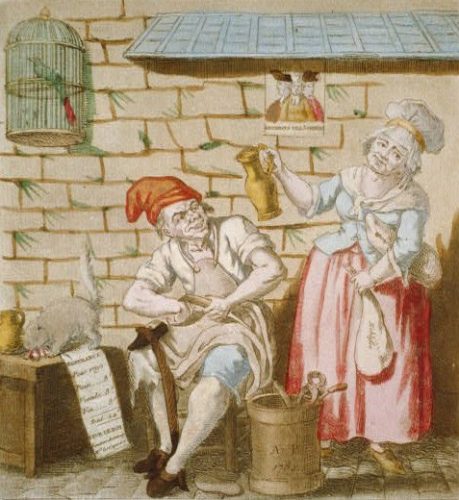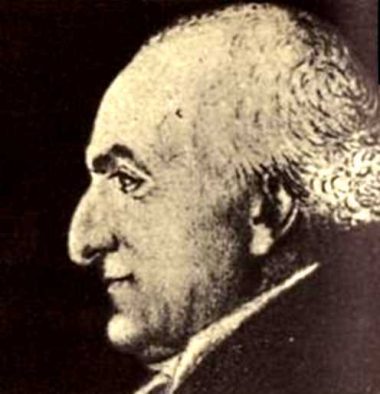
The Law of the Maximum, passed in September 1793, was an attempt by the National Convention to ease the food crisis by fixing a maximum limit for prices. This followed months of agitation and political unrest, culminating in the expulsion of the Girondins from the Convention. The Law of the Maximum was well received by the sans-culottes of Paris but it failed to improve their condition, and in some respects only worsened the problems of food production and distribution.
Background
By 1793, wages, food prices and living conditions in Paris had scarcely improved since the conditions that led to the insurrection of 1789France’s war with Europe had reduced imports and exports and disrupted internal trade. Mobilisation for war and events in the provinces had also disrupted agricultural production.
In the nation’s cities and towns, the introduction of paper assignats had caused severe inflation. The price of a four-pound bread loaf had fallen to eight sous in 1791 – but by 1793 it was up to back up to 12 sous. The cost of other foodstuffs, particularly wine and meat, had also increased markedly. Between 1791 and 1793, inflation pushed food prices up by 90 percent while wages increased by around 80 percent in the same period.
By early 1793 the sans-culottes of Paris were urging the National Convention to resolve food shortages and do something about exorbitant prices.
The Enragés
Leading this campaign were the Enragés (French for ‘enraged ones’). The Enragés were not a political club but a cluster of individuals who, as their name suggests, raged against anyone they believed was profiting from high food prices. The Enragés were, in essence, class levellers who wanted a society of economic equality, the French Revolution’s equivalent of Marxist socialists.
The most prominent member of the Enragés was Jacques Roux, a Catholic clergyman turned radical activist (he was later dubbed the ‘Red Priest’). Roux was politically active in the Paris Commune and the sections but he also worked tirelessly with the poor, trying to locate and distribute food.
Roux’s rousing speeches had little impact on a Convention now dominated by the Jacobins but they were well received on the streets of Paris. In February 1793, the capital was struck by a series of market riots. These riots were started almost exclusively by women protesting against the high price of bread, sugar, coffee, even soap. By late February the riots had been joined by men, threatening violence against bakers and grocers who refused to lower their prices.
Food shortages politicised

The food riots continued in early March when bread shortages began to ease. Between March and June 1793, the Convention was largely occupied by matters of war and a power struggle between the Girondin and Montagnard factions. Radical journalists aligned with the Jacobins began to shift the blame for high food prices to the Girondins. Public perception associated Girondinist deputies with the provinces, with business interests and the bourgeoisie – all this made them convenient scapegoats for the problems of food supply.
At the start of May 1793, the Jacobins in Paris began to side with the sans-culottes over food policy. It was a calculated shift, designed to gain public support and finish off the Girondins for good. Maximilien Robespierre, who had previously shown little sympathy for food rioters or hungry sans-culottes, began to thunder against grain hoarders, price speculators and profiteers.
On May 4th, the Convention took its first steps toward price controls, fixing the price of wheat and flour. Girondins opposed any price controls; they believed that food supplies would soon increase and prices would eventually fall. “These words ‘hoarders’ and ‘monopolies'”, the Girondin deputy Jacques Creuzé-Latouche told the Convention, “are only the dangerous visions of foolish persons and ignorant women”.
The Jacobins in charge
Politically, the leftward shift in Jacobin economic policy had the desired effect. The sans-culottes began to side with the Jacobins and the Montagnards, demanding the removal of the hated Girondins from the Convention. Public pressure continued to build through May 1793, eventually culminating in the journée of May 31st and the expulsion of Girondin deputies on June 2nd.
This was clearly a victory for the Jacobins and the Montagnards in the Convention – but now, they alone were responsible for economic conditions in Paris. There could be no scapegoats and no more blame-shifting.
On June 25th 1793 Jacques Roux delivered a rousing speech to the National Convention, later dubbed the ‘Manifesto of the Enragés‘. In this speech, Roux challenged the Montagnard deputies to take strong action against anyone who monopolised food sales and profited from high prices:
“One hundred times this hall has rung with the crimes of egoists and knaves. You have always promised to strike the bloodsuckers of the people. The constitutional act is going to be presented to the sovereign for sanction. Have you prohibited price speculation [in the new constitution]? No. Have you called for the death penalty against monopolists? No. Have you determined what freedom of commerce consists of? No. Have you forbidden the sale of minted money? No. Well then, we say to you that you haven’t done everything for the happiness of the people.”
Roux silenced
Inc
Rather than heeding Roux’s challenge, the Jacobin machine moved to silence him. In L’Ami du Peuple, Marat condemned Roux as a troublemaker and a “false prices”. Robespierre and his allies followed suit in the Convention. By late August, Roux was languishing in a prison cell on charges that were probably fabricated.
Roux’s disappearance from the political scene did not silence the sans-culottes, who continued to demand action from the Convention. “People are suffering”, said a petition to the Convention in September 1793. “Nobility is crushed but it breathes still in a new elite, merchants and food speculators (the two words are synonymous). Why should the sans-culottes give their blood for the fatherland while the rich get richer? Why should they not rise up and cut off the heads of the rich, as they have done to the courtiers of the king? This will happen unless you fix the maximum.”
Prices fixed
“This General Maximum set prices at the local levels of 1790 plus one third, but undervalued transport costs drastically, encouraging producers to bring their goods to the nearest rather than the neediest market… Across vast swathes of the country, food was unavailable at the Maximum price and required recourse to the black market or payment of a supplemental fee.”
David Andress, historian
On September 29th, just days after this petition, the Convention responded by passing the Law of the Maximum, also known as the General Maximum. This radical legislation imposed a maximum price on dozens of essential goods, mostly food items.
Among the commodities price-capped by the Maximum were “fresh meat, salt meat and bacon, butter, sweet oil, cattle, salt fish, wine, brandy, vinegar, cider, beer, firewood, charcoal, coal, candles, lamp oil, salt, soda, sugar, honey, white paper, hides, iron, cast iron, lead, steel, copper, hemp, linens, woollens, stuffs, canvases, the raw materials used for fabrics, wooden shoes, shoes, turnips and rapeseed, soap, potash and tobacco.”
Under the Maximum, merchants were required by law to display a full list of their maximum prices, posted in a window or outside their store. If any of these prices exceeded the legislated maximum, the general public could inform the city authorities. Merchants who breached the law were fined double the value of each overpriced item. Curiously, the fine was paid to the informer, not the state. The General Maximum also placed a cap on wages.
Economic effects
The move to fix prices and wages was based on good intentions but was economically disastrous, as artificial price controls tend to be.
The limitations imposed by the Maximum discouraged farmers and producers. They began producing less or hoarding what they did produce, rather than selling food below its real value. Less food made its way into the towns and cities, which only exacerbated the shortages there.
Caught in the middle were the urban retailers and petit bourgeoisie – shopkeepers, butchers, bakers and market stall holders – most of whom survived on the slimmest of margins. According to economist Henry Bourne, “the honest merchant who became the victim of the [maximum price] law”, while the disreputable and corrupt exploited it. “The butcher in weighing meats added more scraps than before… other shopkeepers sold second-rate goods at the maximum… The common people complained that they were buying pear juice for wine, the oil of poppies for olive oil, ashes for pepper, and starch for sugar.”
A thriving black market also emerged: many were prepared to risk their lives and freedom by trading illegally with those prepared to pay above the prescribed maximum.

1. The Law of the Maximum was an attempt by the National Convention to fix price levels, in order to appease the sans-culottes and their supporters in the Jacobin movement.
2. By early 1793 food prices had increased again, prompting a series of bread riots in Paris in February and March, and the emergence of economic radicals known as the Enragés.
3. The Jacobins, seeking the political upper hand over the Girondins, began to side with the sans-culottes. On May 4th 1793 the Convention imposed maximum prices on wheat and flour.
4. Continued pressure from Jacques Roux, the Jacobins and the sans-culottes led to the passing of the General Maximum in late September, which fixed wages and prices on a range of essential goods.
5. Rather than solving the problem of food availability and prices, the Maximum made it worse by discouraging farmers and reducing the amount of food coming into towns and cities.
Citation information
Title: ‘The Law of the Maximum’
Authors: Jennifer Llewellyn, Steve Thompson
Publisher: Alpha History
URL: https://alphahistory.com/frenchrevolution/law-of-the-maximum/
Date published: September 30, 2019
Date updated: November 16, 2023
Date accessed: July 27, 2024
Copyright: The content on this page is © Alpha History. It may not be republished without our express permission. For more information on usage, please refer to our Terms of Use.
